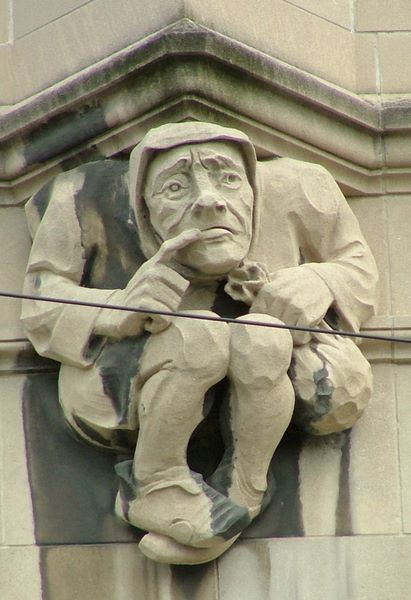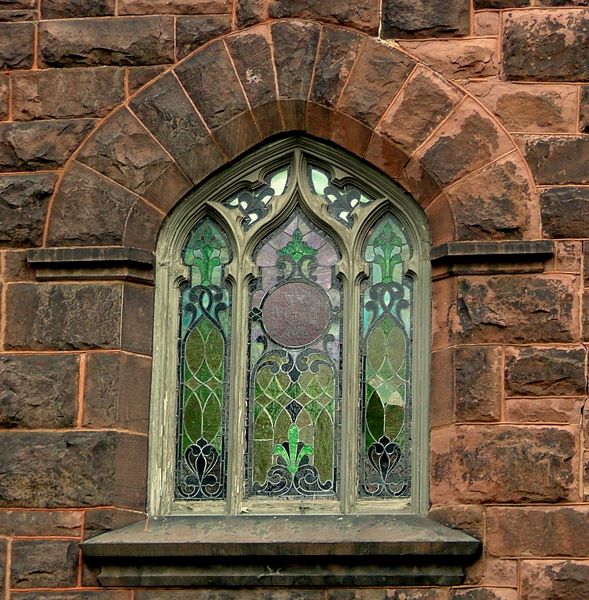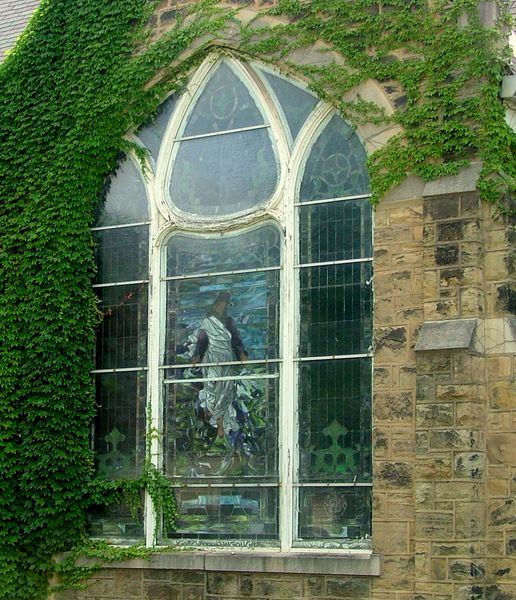|
 Butler Historic District - Butler, Pennsylvania Posted by:  JimmyEv JimmyEv
N 40° 51.505 W 079° 53.723
17T E 593099 N 4523627
Butler has a cute Main Street and a pleasant courthouse square, but the real treat in this city is a few blocks beyond Main. Here you’ll find almost a dozen Gothic and Romanesque Revival churches, each with arches, towers and stunning stained glass.
Waymark Code: WM1YNZ
Location: Pennsylvania, United States
Date Posted: 08/04/2007
Views: 127
|
The Butler Historic District comprises 46 acres with 130 buildings in the center of Butler – what would be
Butler’s downtown if it wasn’t on a rise above the Connoquenessing Creek. Butler was established in 1803
and became a borough in 1817. It was a quiet county seat until the discovery of Butler county’s oil
fields in the second half of the 19th century. That’s when the railroads came and industrial development
of the town began.
|
|
Main Street, from the 1910 Beaux-Arts Masonic Temple
on the south to the 1920 neo-classical T.W. Phillips Company
Office Building on the north, was once Butler’s primary retail corridor. Small independently-owned
shops and restaurants have slowly been filling the historic storefronts that had been left vacant
by major retailers since the 1970s. If you’re walking down Main Street, checking out the shops, don’t
miss the 1898 Rockenstein Building, with its
mail-order storefront from the Mesker Brothers; the 1910
Koch Building, designed by Butler architect F.J. Porter, who also designed the City Hall Building
and First Methodist Episcopal Church; and the mischievous sculptures of shady-looking characters
ringing Butler’s tallest building, the 1925 Art Deco
Butler Savings and Trust Building.
The “High Victorian Gothic with Romanesque accents” Butler
County Courthouse, designed by Pittsburgh architect James P. Bailey in 1885, rises towards the middle
of the Main Street retail corridor. Come here if you want a primer on the differences between Gothic Revival
and Romanesque Revival architecture. You’ll see plenty of both if you go looking at the district’s churches.
The courthouse faces The Diamond, a nicely landscaped
town square full of markers and memorials, including a marker commemorating the Jeep, the first one of which
was manufactured in Butler, and a pretty cool World War II Memorial.
|

|
|
Around the Diamond are the Romanesque/Dutch Colonial 1895
Butler YMCA, probably designed by regional architect S.W. Foulke, and the 1902 Romanesque Revival
Second Presbyterian Church. Like the other churches in
the district, thick heavy stone was used to build a bulky structure decorated with beautiful stained glass.
|



|
Opposite the south side of the courthouse is the 1903 Butler
County National Bank Building, a gorgeous French Renaissance Revival structure and
Butler’s first skyscraper. The building’s primary claim-to-fame is that the Marquis de Lafayette dined
here in 1825. Opposite the north side of the courthouse is the
Butler Eagle Building, with terra cotta eagles providing a graceful flourish to its 1924 Beaux-Arts edifice.
Most of the buildings in the district are commercial and institutional, but there are three early mansions,
two of which are behind the county courthouse. The earliest is the
Senator Lowrie House, built by U.S. Senator Walter Lowrie in 1828. It is the last remaining
example of a Vernacular Greek Revival home in the Butler area. The neighboring
John Quincy Adams Kennedy House, an extravagant French Second Empire mansion, was built for an oil driller
in 1884. The third home in the district hasn’t been used as a house in over seventy years. The Beaux-Arts
1909 Butler City Hall was originally the home of
merchant George A. Troutman. In 1930 it was converted into the Butler City Hall, an early example of adaptive
reuse of historic structures.
Other interestingly historic government buildings scattered about the district include the very different
Schoolhouse No. 1 and Butler High School. Schoolhouse
No. 1 is a small, simple, red brick building – the first public school built in Butler, in 1836. The 1917
Butler High School, a Beaux-Arts building designed
by New Castle architect W. George Eckles, is much, much larger. The school is very similar in design to the
Beaux-Arts YMCA of 1913 around the corner. On the
other side of Main Street is the only Federal building in the district, the 1913
Beaux-Arts U.S. Post Office, typical of post offices
built at the time throughout Western Pennsylvania.
In addition to the Second Presbyterian Church, ten other churches grace the district with their
Romanesque and Gothic designs. Some have intricately detailed trim; all feature beautifully artistic
stained glass. Interestingly, all three of the district’s Presbyterian churches are in the Romanesque Revival
style; the other denominations built Gothic Revival churches.
On the west side of Main Street
is the 1904 First Methodist Episcopal Church, a
collaboration between Butler architect F.J. Porter and Uniontown architect J.C. Fulton; Butler’s oldest
church building, the 1862 Butler Presbyterian Church,
with its chambers for the Underground Railroad; the city’s only Episcopalian church, the 1896
St. Peter’s; the squat 1891
St. Andrew’s United Presbyterian Church; and the
1909 St. Paul Roman Catholic Church, with its
towering steeple and intricately detailed trim.
On the east side of Main Street, connected by the aptly-named Church Street, are the 1927
St Mark’s Sunday School Building, designed by the Boston
firm of Cram and Ferguson; the 1914 First Baptist Church;
the 1913 Grace Lutheran Church; the 1911
Bethany Reformed Church, whose congregation consisted of members of the St. Paul’s Reformed Church that
didn’t want to move across the Connoquenessing; and the 1924
Church of Christ, with its beautifully carved entrance doors.
|
Street address:
Bounded by North Church St., South Walnut St., Franklin St. and Wayne Street
Butler, PA USA
16001

County / Borough / Parish: Butler County

Year listed: 2003

Historic (Areas of) Significance: Event, Architecture/Engineering

Periods of significance: 1825-1974

Historic function: Central Business District

Current function: Central Business District

Primary Web Site: [Web Link]

Privately owned?: Not Listed

Season start / Season finish: Not listed

Hours of operation: Not listed

Secondary Website 1: Not listed

Secondary Website 2: Not listed

National Historic Landmark Link: Not listed

|
Visit Instructions:
Please give the date and brief account of your visit. Include any additional observations or information that you may have, particularly about the current condition of the site. Additional photos are highly encouraged, but not mandatory.
|